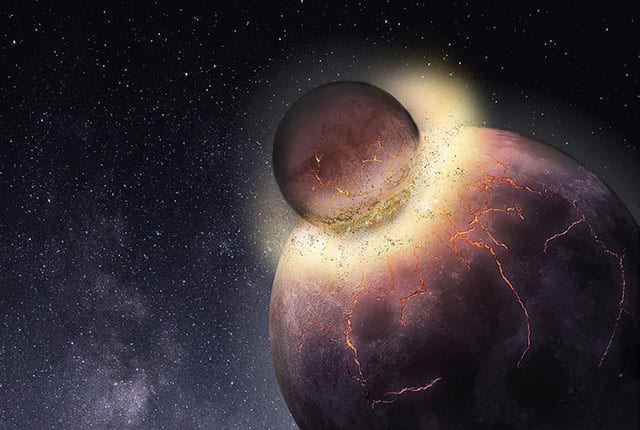Our Moon is a jewel in our night sky. The night sky just wouldn’t feel right without the Moon. But the Moon wasn’t there all the time. So Where did our natural satellite come from?
After the sun spun to light, the planets of the solar system began to form. But it took another hundred million years for Earth’s moon to spring into existence. There are three theories as to how our planet’s satellite could have been created: the giant impact hypothesis, the co-formation theory and the capture theory.
Once Copernicus gave us our current model of the Solar System, with the Earth as just another planet and the Sun at the centre of the Solar System, this gave us a new way of looking at the Moon.
The first modern idea about the formation of the Moon was called the fission theory, and it came from George Darwin, the son of Charles Darwin. He reasoned the Moon must have broken away from our planet when the Earth was still a rapidly rotating ball of molten rock. His theory lasted from the 1800s right up until the space age. Another idea is that the Earth captured the Moon after its formation.
GIANT IMPACT HYPOTHESIS
The most widely accepted theory is that the Moon was formed when a Mars-sized object slammed into the Earth, billions of years ago. This collision turned the newly formed Earth into a molten ball of rock again and ejected material into orbit.
Theia, the Mars-sized body, that collided with Earth, started throwing vaporized chunks of the young planet’s crust into space. Gravity bound those ejected particles together, creating a moon that is the largest in the solar system in relation to its host planet.
This sort of formation would explain why the moon is made up predominantly of lighter elements, making it less dense than Earth — the material that formed it came from the crust while leaving the planet’s rocky core untouched. As the material drew together around what was left of Theia’s core, it would have centred near Earth’s ecliptic plane, the path the sun travels through the sky, which is where the moon orbits today.
Although this is the most popular theory, it is not without its challenges. Most models suggest that more than 60% of the moon should be made up of the material from Theia. But rock samples from the Apollo missions suggest otherwise.
CO-FORMATION THEORY
Moons can also form at the same time as their parent planet. Under such an explanation, gravity would have caused material in the early solar system to draw together at the same time as gravity-bound particles together to form Earth. Such a moon would have a very similar composition to the planet and would explain the moon’s present location.
However, although Earth and the moon share much of the same material, the moon is much less dense than our planet, which would likely not be the case if both started with the same heavy elements at their core.
CAPTURE THEORY
Perhaps Earth’s gravity snagged a passing body, as happened with other moons in the solar system, such as the Martian moons of Phobos and Deimos. Under the capture theory, a rocky body formed elsewhere in the solar system could have been drawn into orbit around Earth.
The capture theory would explain the differences in the composition of Earth and its moon. However, such orbiters are often oddly shaped, rather than being spherical bodies like the moon. Their paths don’t tend to line up with the ecliptic of their parent planet, also unlike the moon.
Anyway, the Earth would be a very different place if the Moon did not exist. Not only did the Earth slow down the Moon’s rotation, but the Moon is slowing down the rotation rate of the Earth. Since the moon’s formation, the Earth has been slowing its rotation due to the friction of the tides caused by the moon, and in reaction to this exchange of energy, the moon has been moving farther away from the Earth.
In fact, at the time of the moon’s formation, the Earth rotated much faster than it does today; a day on early Earth was only a few hours long. But the Moon, being small in relation to Earth, will take more than twice the age of the solar system to slow Earth’s spin rate to the Moon’s orbital rate.



